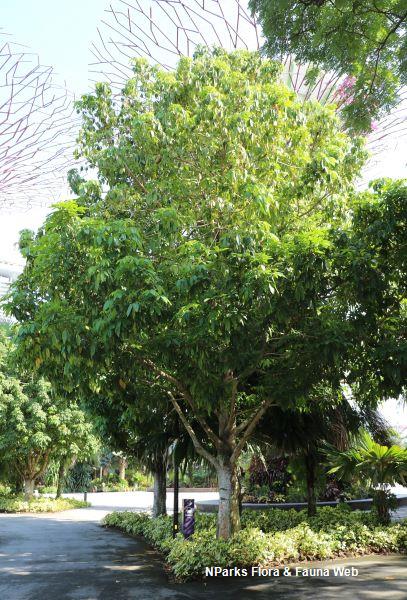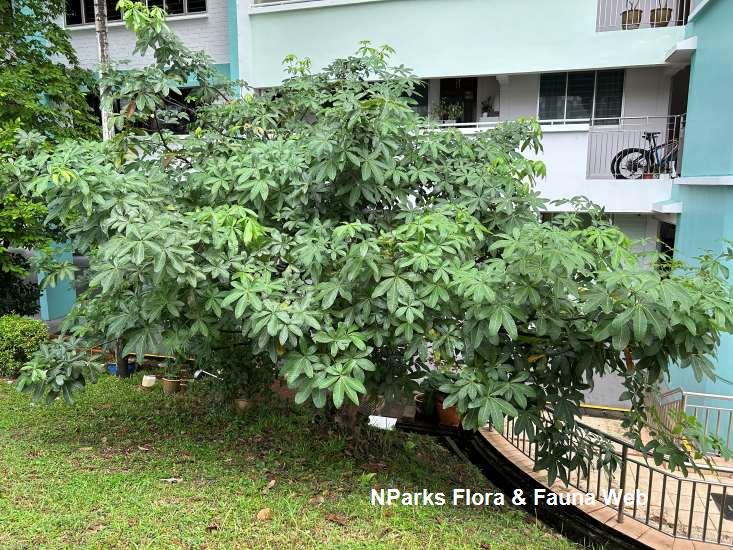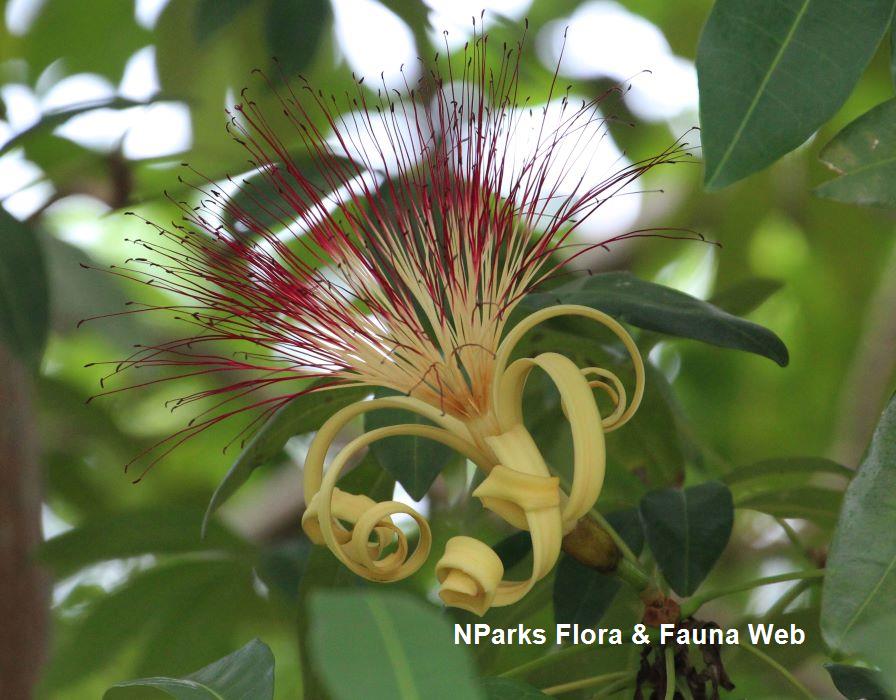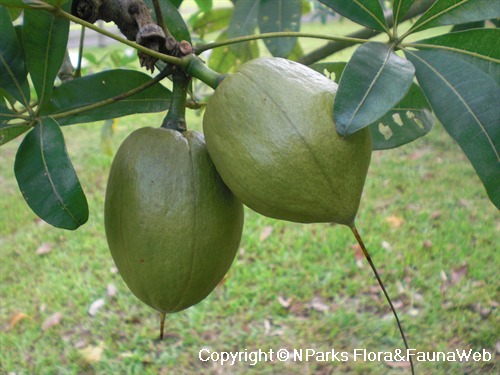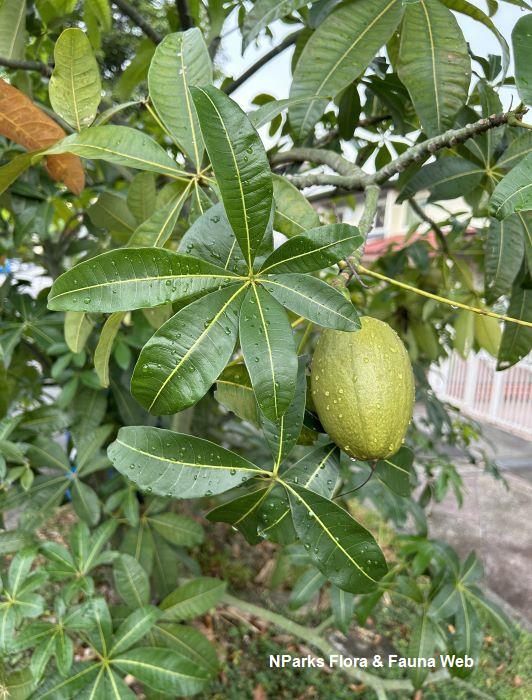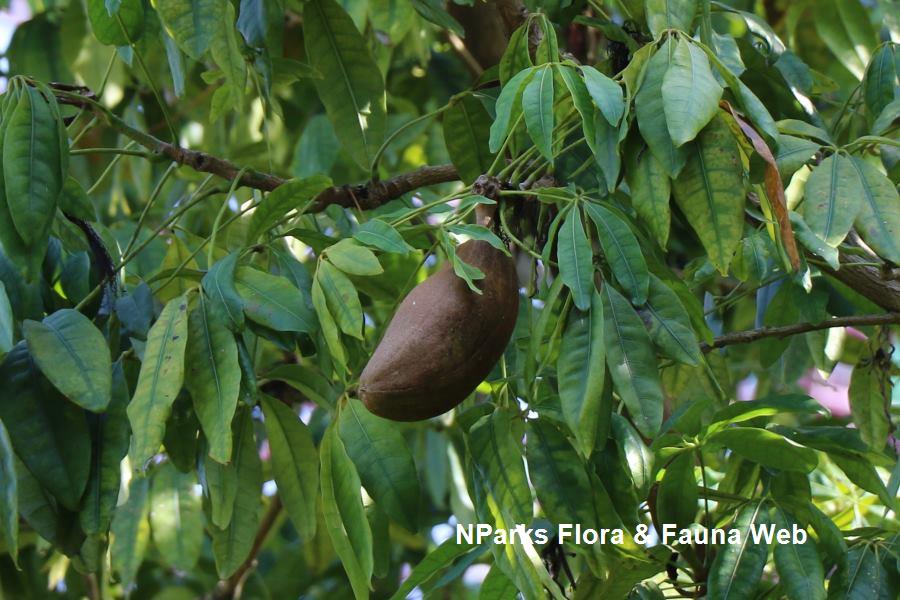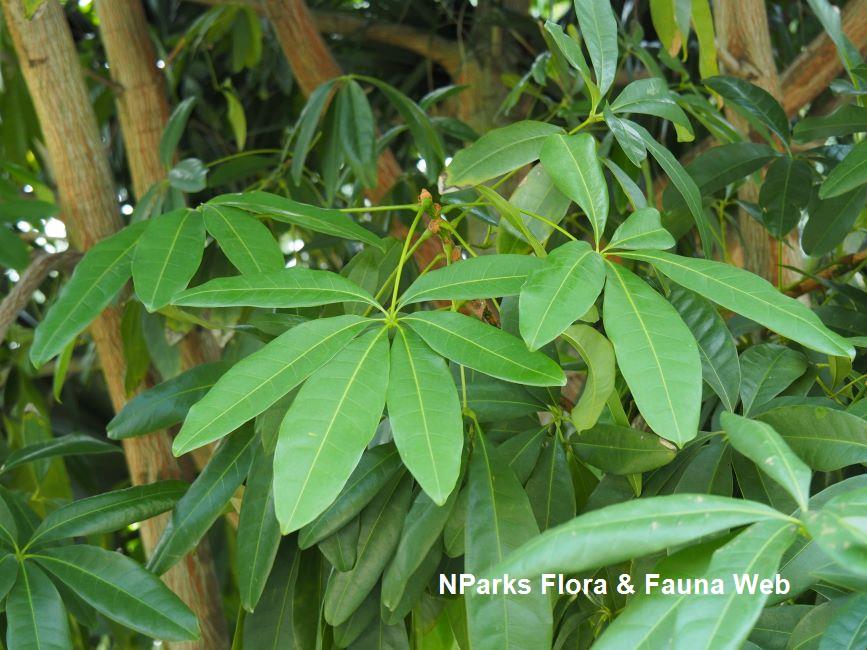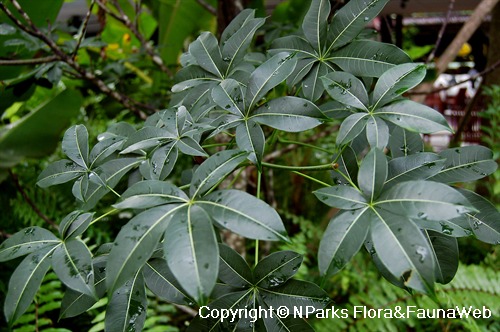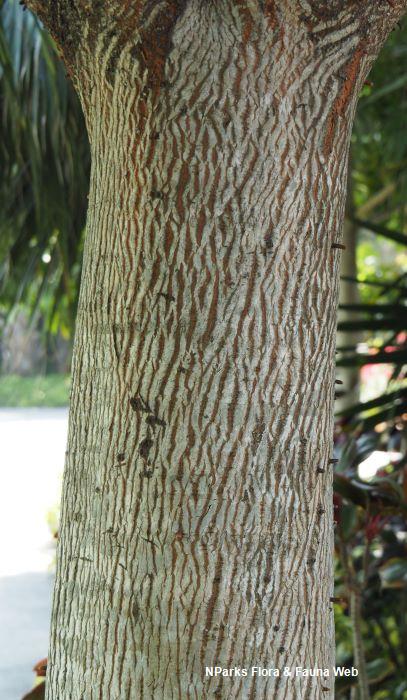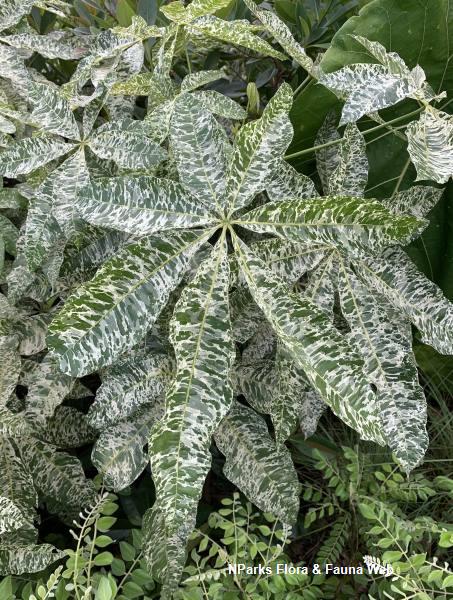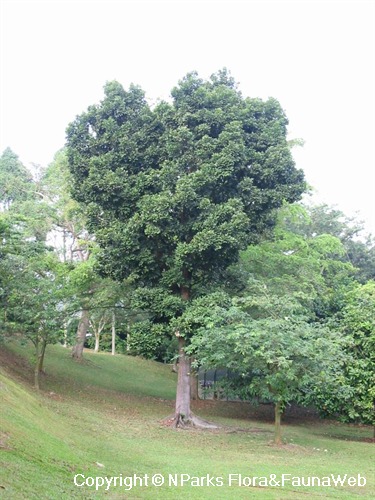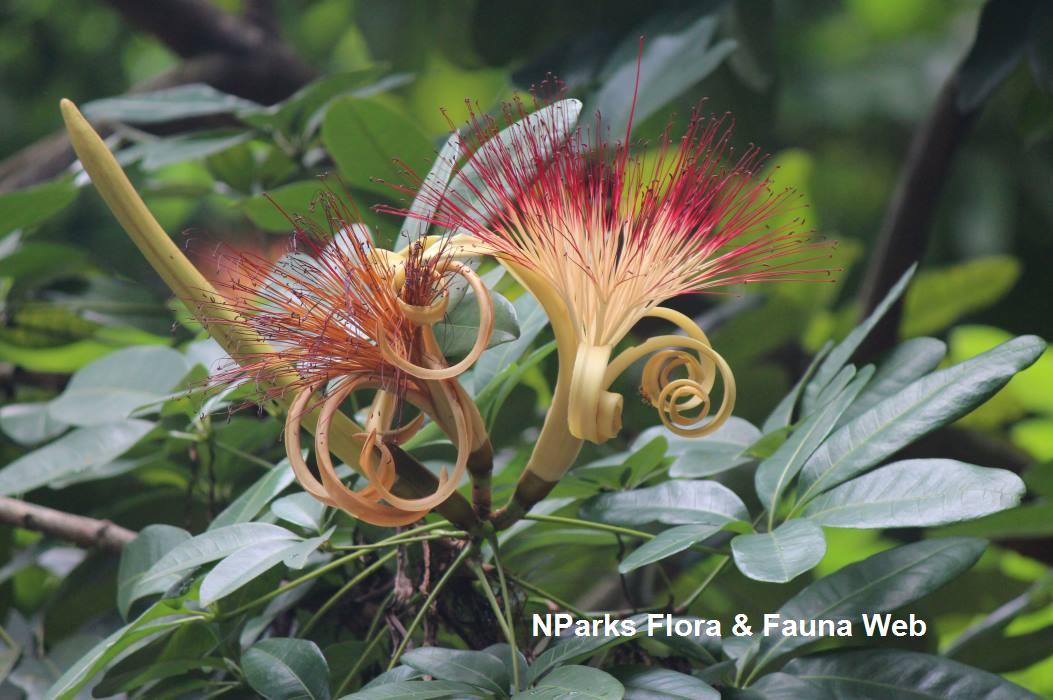
Back
Pachira aquatica Aubl.
| Family Name: | Malvaceae |
| Synonyms: | |
| Common Name: | Guiana Chestnut, Malabar Chestnut, Money Tree, 瓜栗, 发财树 |
Pachira aquatica , commonly known as Guiana chestnut, is a tree with palmate leaves and fragrant brush-like flowers. The seeds can be boiled, fried, roasted and ground to make a chocolate-like beverage, likely consumed by locals in South America and Mexico. They are said to that taste like roasted peanuts or chestnuts.
Name
Classifications and Characteristics
| Plant Division | Angiosperms (Flowering Seed Plants) (Dicotyledon) |
|---|---|
| Plant Growth Form | Tree |
| Lifespan (in Singapore) | Perennial |
| Mode of Nutrition | Autotrophic |
| Plant Shape | Rounded |
| Maximum Height | 23 m |
Biogeography
| Native Distribution | Mexico to South America |
|---|---|
| Native Habitat | Terrestrial |
| Preferred Climate Zone | Tropical |
| Local Conservation Status | Non-native |
Description and Ethnobotany
| Growth Form | It is a tree that can reach up to 23 m in its natural habitat. The trunk can grow up to 70 cm in diameter and may develop buttresses. |
|---|---|
| Foliage | Leaves are arranged alternately and are palmate with 5 – 7 (– 9) leaflets. Leaflets are oblong-obovate to elliptic, measuring about 5 – 29 cm long and 3 – 15 cm wide, with entire margin. |
| Flowers | Flower occurs in solitary and is borne on a short flower stalk, measuring 1 – 5.5 cm. It is fragrant, and has a brush-like appearance, comprising 5 greenish-white to brown petals, numerous stamens with red tips and a broadly ovoid ovary. |
| Fruit | The fruit is woody, capsular and elliptic to subglobose, measuring about 20 (– 30) cm long and 10 (– 12) cm wide. It splits into 5 valves at maturity, revealing seeds surrounded by white, fleshy pulp. |
| Habitat | It is found in forest near streams and rivers. |
| Associated Fauna | It is likely pollinated by bats. |
| Cultivation | It can be propagated by seeds, stem cuttings and grafting. |
| Etymology | The genus epithet is derived from the Guyanese name. Specific epithet aquatica, in Latin, means water, referring to the plant’s natural habitat of growing in or near water. |
| Ethnobotanical Uses | Edible Plant Parts : Edible Leaves, Edible Seeds Food (Fruit or Vegetable): The seeds are edible and they can be boiled, fried, roasted and ground to make a chocolate-like beverage, likely consumed by locals in South America and Mexico. <9,10> Seeds are said to that taste like roasted peanuts or chestnuts. In Panama and Colombia, the seeds are ground into flour for baking bread. In South America, the young leaves and flowers are eaten cooked as a vegetable. <9, 10, 11> Timber & Products: The wood is used to make pulp for paper, boxes, handicrafts, and carpentry work. The bark yields a dye that is used to color sails, ropes, and fishing nets Others: Popularly cultivated as houseplants for ornamental purposes, they are often sold under the trade name 'Money Tree', either with a single trunk, or as multiple plants with braided stems. |
Landscaping Features
| Desirable Plant Features | Ornamental Flowers |
|---|---|
| Landscape Uses | Container Planting, Interiorscape/ Indoor Plant, General, Riverine, Shade Providing Tree / Palm, Hedge / Screening |
Fauna, Pollination and Dispersal
| Fauna Pollination Dispersal Associated Fauna | Bat Food |
|---|---|
| Pollination Method(s) | Biotic (Fauna) |
| Seed or Spore Dispersal | Abiotic (Water) |
Plant Care and Propagation
| Light Preference | Semi-Shade, Full Sun |
|---|---|
| Water Preference | Moderate Water, Lots of Water |
| Plant Growth Rate | Moderate |
| Rootzone Tolerance | Waterlogged Soils (Drains Site), Easy to Grow |
| Maintenance Requirements | Moderate |
| Propagation Method | Seed, Stem Cutting |
Foliar
| Foliage Retention | Evergreen |
|---|---|
| Mature Foliage Colour(s) | Green |
| Foliar Type | Compound (Palmate) |
| Foliar Arrangement Along Stem | Alternate |
| Foliar Shape(s) | Non-Palm Foliage (Elliptical, Oblong, Obovate) |
| Foliar Margin | Entire |
| Typical Foliar Area | Mesophyll ( 45cm2 - 182.25 cm2 ) |
| Leaf Area Index (LAI) for Green Plot Ratio | 4.0 (Tree - Dense Canopy) |
Non - Foliar and Storage
| Trunk Type (Non Palm) | Woody |
|---|---|
| Stem Type & Modification | Woody |
| Root Type | Underground |
Floral (Angiosperm)
| Flower & Plant Sexuality | Bisexual Flowers |
| Flower Colour(s) | Cream / Off-White, Green, Brown |
|---|---|
| Flower Grouping | Solitary |
| Flowering Habit | Polycarpic |
Fruit, Seed and Spore
| Fruit Classification | Simple Fruit |
|---|
References
| References | <1> Carvalho-Sobrinho, J., Yoshikawa, V. N. & Dorr, L.J. (2021). Notes on Brazilian Pachira (Malvaceae, Bombacoideae) II: Additional typifications and new synonymies. PhytoKeys 186: 53–72 <2> Condit, R., Pérez, R. & Daguerre, N. (2011). Trees of Panama and Costa Rica. Princeton and Oxford: Princeton University Press. 496 pp. <3> Croat, T.B. (1978). Flora of Barro Colorado Island. Stanford, California: Stanford University Press. 943 pp. <4> Daim Costa, L., Pereira Trindade, R., da Silva Cardoso, P., Barros Colauto, N., Andrea Linde, G. & Murowaniecki Otero, D. (2023) Pachira Aquatica (Malvaceae): An Unconventional Food Plant with Food, Technological, and Nutritional Potential to Be Explored. Food Research International Vol 164. <5> de Lacerda, L.D. (2002). Mangrove Ecosystems: Function and Management. Berlin: Springer Verlag. 292 pp. <6> Duarte, O. & Paull, R. E. (2008). Pachira aquatica Malabar chestnut. In: Janick, J. & Paull, R.E. (eds) The Encyclopedia of Fruit and Nuts, pp. 182 – 184. Cambridge, United Kingdom: Cambridge University Press. <7> Gargiullo, M.B., Magnuson, B & Kimball, L. (2008). A Field Guide to Plants of Costa Rica. New York, USA: Oxford University Press Inc. 544pp. <8> Ospina, J.A. (2002). Bombacaceae (Kapok Tree Family). In: Vozzo, J.A. (ed.) Tropical Tree Seed Manual. Washington DC, USA: USDA Forest Service, Agriculture Handbook 721. 899 pp. <9> Rodrigues, A.P., Pereira, G.A., Tomé, P.H.F., Arruda, H.S., Eberlin, M.N., Pastore, G.M. (2019) Chemical Composition and Antioxidant Activity of Monguba (Pachira aquatica) Seeds. Food Research International vol 121: 880–887. <10> Rodrigues, A. P. & Pastore, G. M. (2021). A review of the nutritional composition and current applications of monguba (Pachira aquatica Aubl.) plant. Journal of Food Composition and Analysis 99: 1 – 12 <11> van der Vossen, H.A.M. & Umali, B.E. (Editors). 2001. Plant Resources of South-East Asia Volume 14. Minor Vegetable Oils and Fats. Indonesia: Prosea Foundation. 229 pages. |
|---|
Image Repository
Others
| Master ID | 1752 |
|---|---|
| Species ID | 3045 |
| Flora Disclaimer | The information in this website has been compiled from reliable sources, such as reference works on medicinal plants. It is not a substitute for medical advice or treatment and NParks does not purport to provide any medical advice. Readers should always consult his/her physician before using or consuming a plant for medicinal purposes. |

